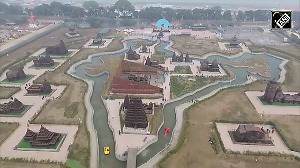What makes the allocation difficult is that not all reserves are proven and not all proven reserves are exploitable.
Besides, there are multiple categories of claimants -- existing steel mills with allotted mines, existing steel mills without allotted mines, and domestic and foreign applicants wanting to set up new projects.
Also, there are iron ore exporters who have signed long-term international contracts to sell ore from mines allotted to them.
And politics is muddying the waters further. Left politicians, nationalists and the domestic steel industry want an end to iron ore exports to maximise domestic value addition through steel-making. Ore-rich states have gone one step further.
They want new plants to be located in them -- they are against the export of iron ore to other states -- but the domestic steel industry and non-iron ore bearing states are against this.
India has approximately 23.59 billion tonnes of iron ore, mainly in Jharkhand, Orissa, Chhattisgarh, Karnataka and Goa. However, this estimate is not very meaningful as only 6.31 billion tonnes are "proven" reserves while the balance is "probable and possible reserves".
Of the entire reserves, haematite accounts for 12.9 billion tonnes. The steel industry is dependent on haematite since a majority of the remaining 10.68 billion tonnes of magnetite is found mainly in the Western Ghats, an ecologically sensitive area where the Supreme Court has stopped mining.
So only proven reserves of haematite and the odd bits of proven magnetite reserves outside the Western Ghats are available for immediate mining.
It is no wonder that a lot of haggling and one-upmanship is on. A report by the Associated Chambers of Commerce and Industry says with sustained growth in steel production, 12.5 billion tonnes of haematite will be exhausted by 2035.
Not surprisingly, the steel industry is urging the government to ban iron ore exports. Iron ore production in 2005-06 was 165 million tonnes, of which 90 million tonnes were exported.
Union Steel Minister Ram Vilas Paswan, H D Kumaraswamy, Chief Minister of Karnataka, West Bengal Chief Minister Buddhadeb Bhattacharjee and Rajasthan Chief Minister Vasaundhara Raje (both non-iron ore rich states) have sought Prime Minister Manmohan Singh's intervention to introduce the ban.
An inter-ministerial panel has been constituted to look into the matter and it has recommended that iron ore exports be frozen at current levels for three years. But what is current -- last year's level or this year's? Last year's export level has reportedly been reached in the first eight month of this year.
To sort out the issue, the government appointed a committee under Planning Commission member Anwarul Hoda to give directions for a national mineral policy. Some of its recommendations have divided the steel industry.
According to one recommendation, steel capacities already in existence on July 1, 2006, which do not have captive mines, should be given preferential allocation of mines fully prospected by public agencies without going through auctions. However, a state can waive the auction for a new unit if it wants to.
But the criteria for waiver are not clear. If a state waives the auction for foreign steel majors the domestic steel players queuing up for mines will be left out -- there are not enough proven reserves for every fresh applicant.
This explains why every applicant has its eye on the Chiria mines, leased to Steel Authority of India Ltd. With estimated reserves of 2 billion tonnes, it is one of the few proven reserves.
The Chiria mines were previously allotted to the erstwhile Indian Iron and Steel Company, which did not exploit them. IISCO became sick, was acquired by SAIL, and was eventually merged with it. So the mines should have gone to SAIL.
However, in 2005, the Jharkhand government cancelled two of the six leases comprising the Chiria mines on the grounds that IISCO had not exploited them for a long time. SAIL resorted to legal action and has won the first round.
The sites coming under the cancelled leases figure in an unwritten assurance reportedly given by the government not just to Mittal Steel, but also to some of the domestic steel producers.
Sanak Mishra, chief executive officer of Mittal Steel India, said, "We are still interested in Chiria." Meanwhile, foreign investors are beginning to get skeptical about the Indian authorities' ability to allocate mines to get new projects going.
If the iron ore issue is not sorted out, India's dream of attracting $125 billion investment in steel over the next 10 years will remain just that.







 © 2025 Rediff.com -
© 2025 Rediff.com -